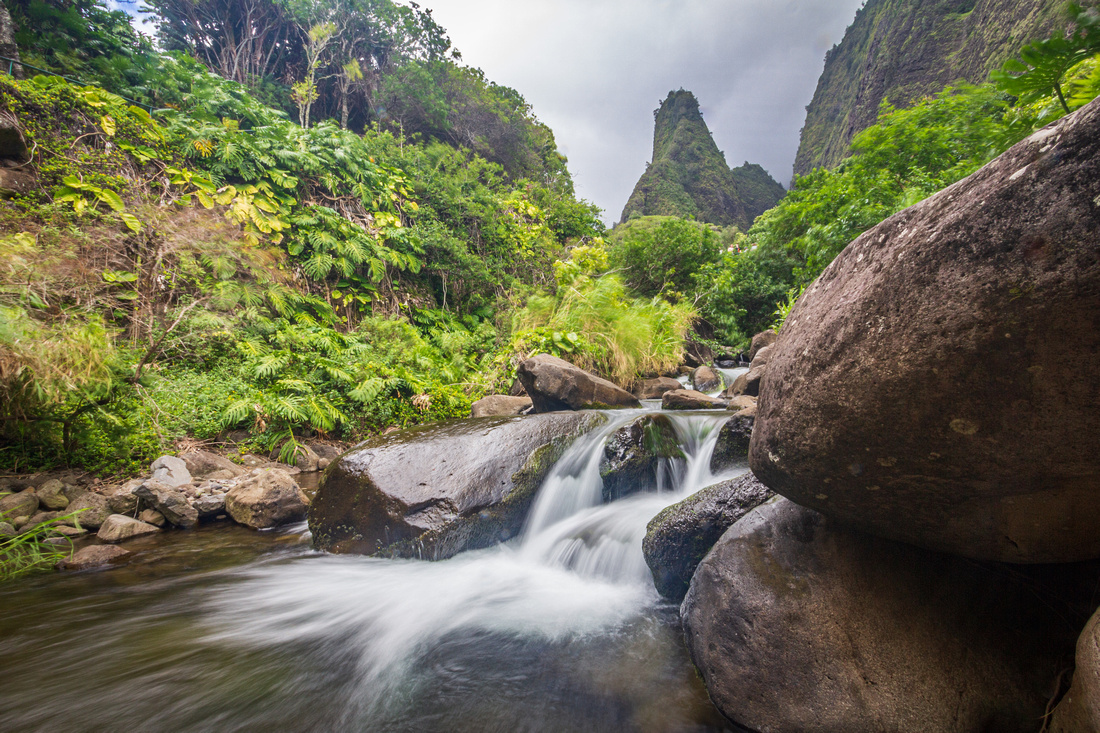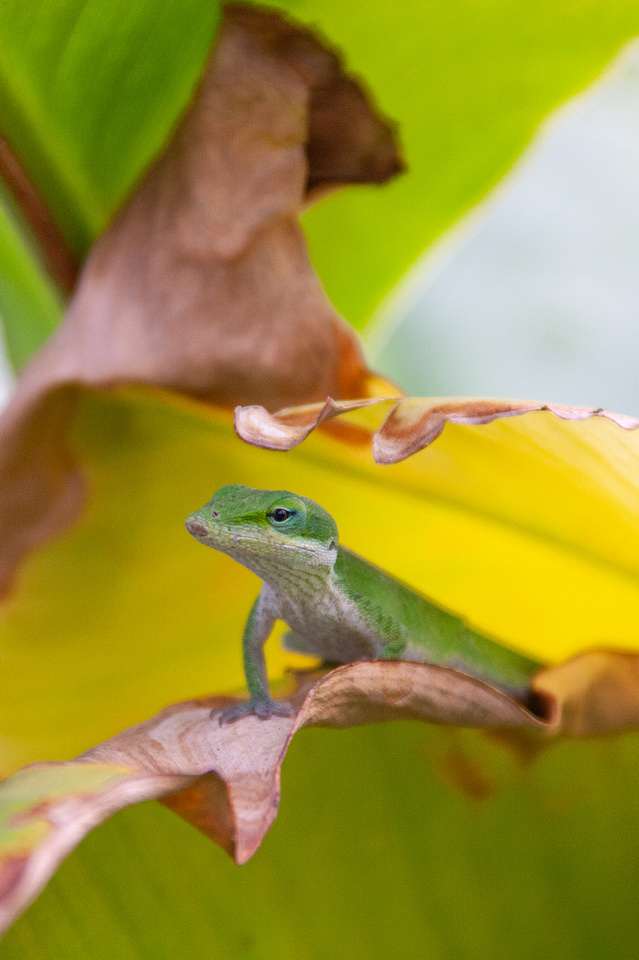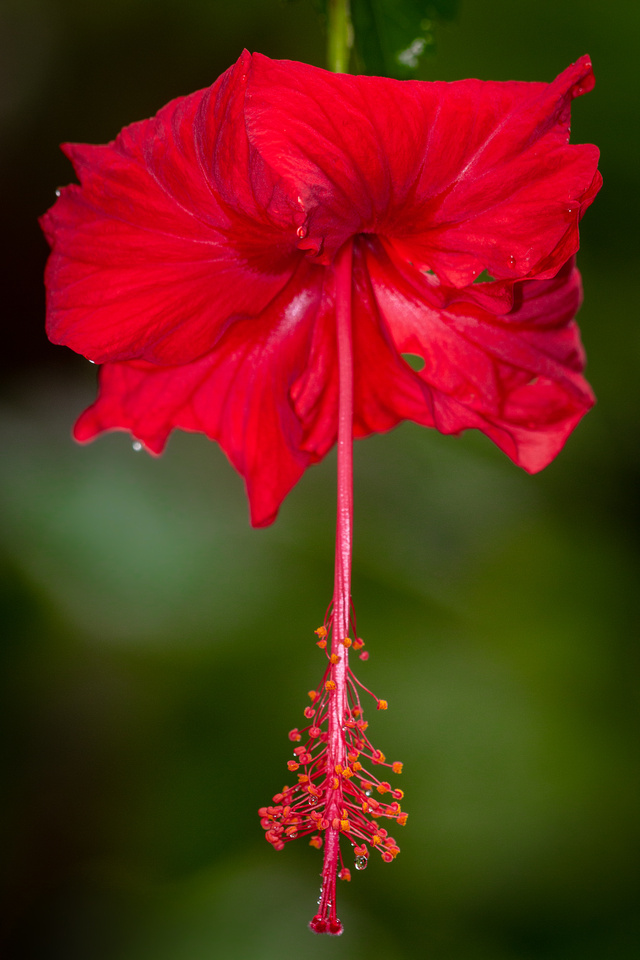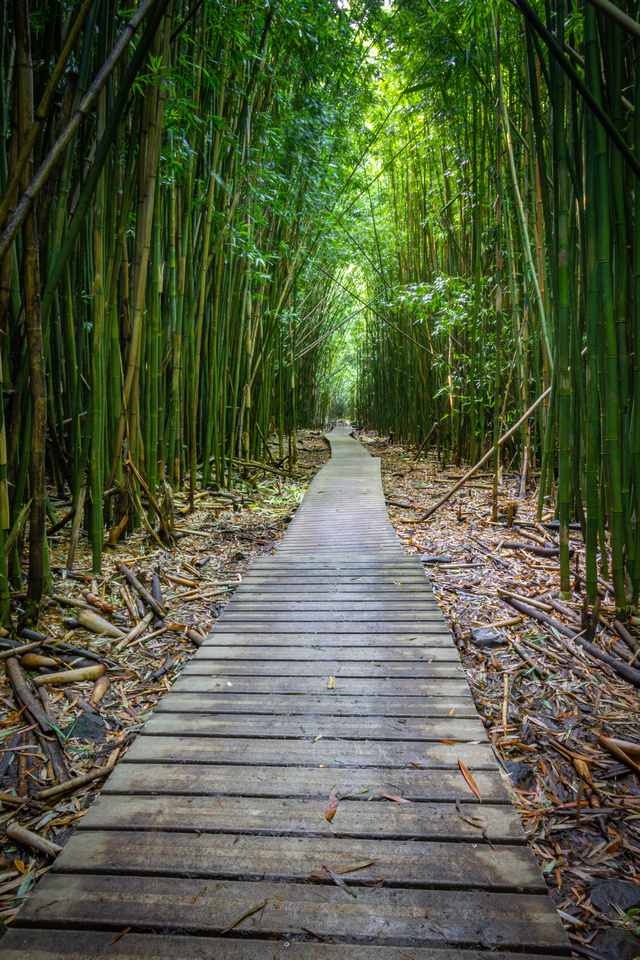Mini Maui travel and photo guide
The island of Maui is beautiful. Between the scenic beaches, waterfalls, plant, and wildlife, it is a photographer's delight. But even if you aren't that interested in taking pictures, there are many wonderful things to see and do that make this a top notch destination. I've been fortunate enough to travel around and photograph many areas of the island and decided to create a mini photo guide.
Maui is a small island and it is easy to travel from one end to the other in a day, but when possible, I like visit areas that are within the same geographical location, so while I have organized features by logical categories below, I've also included their location on the island to make it easier for you to plan your own route.
To see the full Maui Photo Gallery, click here. I hope you enjoy!
| Beaches & Coastal Features
|
|
Napili Bay| Rating: 4 | Location: Lahaina, North-West Description: This area is similar to Kaanapali in terms of sunrise and sunset lighting. I really liked the rocks on this beach, but it is small, so there aren't extensive photo compositions available. If you are more interested in enjoying the beach, this is a good one for swimming and lounging and there are restaurants within walking distance.
|
|
Kaanapali Beach | Rating: 4 | Location: Kaanapali, West Description: If you are staying in Kaanapali, this location can't be beat for it's walking trail and easy access to the beach. Despite being west facing, this area made a nice location for both sunrise and sunset photos. Kaanapali is also set among many hotels, resorts, shopping, and restaurants, so even if you aren't staying here, you can easily enjoy a nice sunset after dinner in the area.
|
|
Ukumehame Beach | Rating: 5 | Location: West Description: This beach is outstanding for it's trees. They make for really unique images, and since this faces west, it is a good sunset option. This is also a popular spot for surfing and while it is pretty mellow on the weekdays, it can get crowded on the weekends. This beach is located at mile marker 12 of Honoapi'ilani Highway. It is very easy to access with ample street parking close to the beach, but watch for deep sand.
|
|
Makena Beach | Rating: 5 | Location: South-West Description: We spent several hours at Makena Beach and I photographed non stop the entire time. It is a popular beach for families and picnics but I didn't have any challenges keeping people out of my images. This beach has all the makings for an iconic Hawaiian image, especially at sunset.
|
|
Pa'ako Cove (aka: Secret Cove)| Rating: 5 | Location: South-West Description: Secret Beach is stunning, but it is a bit of a nightmare to photograph. Parking is limited so you need to arrive early if you want a spot for sunset. You will know you have found the right beach when you are parking alongside a lava rock wall. The beach is just on the other side of that wall. I thought I lucked out when we arrived in the afternoon to an empty beach, but as the light got good, a variety of people descended on this beach for weddings, family portraits, and to watch the sunset. I've never had so many people walk directly into my frame as I did at this location (note the fisherman in the distance). It's a public beach, so everyone has a right to be there, just pack your patience if you go!
|
| State & National Parks
|
|
Haleakala National Park | Rating: 5 | Location: East Description: many people visit the summit of Haleakala for sunrise, and if you would also like to do that, make sure you go the national park service website to secure your reservations. You may also want to pack some warm clothes because it is not uncommon for windy and freezing temperatures up there at sunrise. While I enjoyed watching the sunrise here, I think I liked visiting later in the morning even more as it was a bit warmer, the crowds had disappeared, and we were able to hike a portion of the sliding sands trail. The clouds linger up here so it makes for some unique photography as well.  
|
|
lao Needle State Park | Rating: 5 | Location: Central Description: Iao Valley State Park is 4,000 acres of lush green scenery and the Iao Needle peak. It’s also the second wettest location in Hawaii, getting 386 inches of rain a year. The Iao Needle Trail is a short, easy hike on a paved path at just over a half mile long, so this makes a great stop, even if you don't have a lot of time. I found several good spots to photograph along the Iao Valley Creek while I was visiting. It was very cloudy when I was there, but that is to be expected with all the rain it gets!  
|
| Waterfalls
|
|
Honokohau Falls | Rating: 5 | Location: North-West Description: Honokohau Falls is said to be the tallest waterfall on Maui, at over 1,000 feet, but you cannot drive or hike to it as it is located in an inaccessible valley of the West Maui mountains. It can only be seen from the air and a helicopter tour is the best way to get a good look.
|
|
Twin Falls | Rating: 4 | Location: East, Road to Hana Description: The trail to Twin Falls is located at mile marker 2 on the Road to Hana. You used to be able to park here for free, but now you must pay $10 to park in one of the privately owned lots. Since this is the first attraction on the Road to Hana, it gets crowded early so the lots may be full, but it didn't seem like people lingered here for long so spots probably turn over fairly quickly. The hike to the falls is just under 2 miles round trip. You do hike up hill on the way there, but I wouldn't qualify it as difficult by any means.
|
|
Falls at Pua'a Ka'a State Wayside | Rating: 4 | Location: East, Road to Hana Description: The Pua'a Ka'a State Wayside is located just past mile marker 22 on the Road to Hana. There is a paved trail to several small falls and a dirt trail to a larger falls up stream. This is a nice stop for a picnic, to stretch your legs, and to check out some of the beautiful waterfalls along the road to Hana.
|
|
Hanawi Falls | Rating: 5 | Location: East, Road to Hana Description: Hanawi Falls is located right after mile marker 24 on the Road to Hana. There are a couple of narrow pull outs near the falls and the best location to take a photo is from the Hanawi Stream bridge. I found this to be a quick and easy stop for a picturesque waterfall.
|
|
Wailua Falls | Rating: 5 | Location: East, Road to Hana Description: Located just past mile marker #45 on the road to Hana, this is one of Maui's most accessible and scenic waterfalls. There is ample parking here and you can easily see the falls without any hiking.
|
|
Waimoku Falls | Rating: 5 | Location: East Description: Waimoku Falls plunges 400 feet and is the main attraction on the 4 mile round trip Pipiwai Trail. The trailhead is located north of the O'heo Gulch, 12 miles past Hana. The easiest and closest parking is inside the Haleakala National Park lot and is just across the street from the upper lot. The trail can get a little muddy and there was a sea of mosquitos when we visited so having some bug spray is a life saver.
|
|
Unnamed Falls #1, Pipiwai Trail | Rating: 5 | Location: East, Road to Hana Description: this is one of the waterfalls we past while hiking to Waimoku Falls. I have never been able to identify it but it was worth stopping to photograph.
|
|
Unnamed Falls #2, Pipiwai Trail | Rating: 5 | Location: East, Road to Hana Description: this is the second of the waterfalls we past while hiking to Waimoku Falls. I also have not been able to identify this one by name, but it is pretty little waterfall coming out of a lush green valley. The water volume is probably mush larger during the rainy season.  
|
|
O'heo Gulch | Rating: 3 | Location: East, Road to Hana Description: located 12 miles past Hana, access to the O'heo Gulch is via a paved path inside the Haleakala National Park area. This is a fee area at $30 per vehicle but that gives you a 7 days pass that you can use if visiting the summit as well. Access to the pools themselves was closed when I visited so I had to locate a vantage point along the trail and shoot the falls from a longer focal length, roughly 300 mm.  
|
| Man Made Features
|
|
Mala Pier | Rating: 4 | Location: West, Lahaina Description: Mala pier was once a functioning pier until it was destroyed during a storm in 1992. This is located next to a marina where a lot of fishing and excursion boats depart. If the tide is low enough, you can get under the pier without getting too wet to get some unique images. This is also a nice snorkeling location. I did not get in the water while I was here but I saw about 5 large green sea turtles feeding on the algae growing on the rock jetty nearby.
|
|
Maui Ocean Center | Rating: 4 | Location: Central, Maalaea Description: The Maui Ocean center is a 3 acre facility with living reef and deep sea aquariums, a turtle lagoon, and humpback whale exhibit and movie. It is not a massive aquarium but it has some nice educational exhibits and it wasn't overly crowded, making it easy to take photos. My favorite part was the turtles and I could have stayed in that section for hours watching the turtle feed and glide through the water.  
|
| Wildlife
|
|
Red Crested Cardinal Description: This small songbird is known for its overall gray body and bright red crest that make it easy to identify. It’s native to Brazil and is not actually related to the true Cardinal family. You can find the Red-Crested Cardinal in the lowlands of the main Hawaiian islands.
|
|
Green Anole Description: The green anole was introduced to Hawaii in the 1950s via the pet trade. It can be found in high humidity areas, near plants with large leaves. It spends more time in the trees than on the ground like it's relative, the brown anole. Their diet includes spiders, flies, crickets, small beetles and other insects.  
|
|
Cardinal Description: The cardinal is large compared to other songbirds, It was introduced to Hawaii in 1929 and can now be found throughout Hawaii. They feed on seeds, fruit, and insects.  
|
|
Common Myna Description: The Common Myna is usually seen in pairs, strutting across the ground. This bird was introduced in 1856 and is considered an invasive species because of the damage it causes to ripening fruit. It feeds on insects, crustaceans, reptiles, small mammals, and grains. Common Mynas pair for life and build their nests using twigs, rubbish, tin foil, and sloughed-off snakeskin. They’re also often found roosting in banyan trees.  
|
|
Cattle Egret Description: The cattle egret is extremely widespread since its introduction to Hawaii from Florida in 1959. The Hawaii Board of Agriculture and Forestry, with the support of cattle ranchers, imported young Cattle Egrets to control house flies, horn flies, and other flies that damage hides and cause lower weight gains in cattle. They are now considered a pest as they are nest predators of Hawaiian Stilts and Hawaiian Coots. Easy to spot, these white birds are often seen in large groups, usually near ponds and golf courses.  
|
|
Gold Dust Day Gecko Description: the Gold Dust Day Gecko is a brilliant green lizard. They have a few super powers including the ability to drop their tail if they believe they are in danger and re grow it within a matter of weeks. They also have color vision 350 times more effective than humans. Many islanders welcome these lizards into their homes due to their diet of mosquitoes, cockroaches, flies and spiders. They will also drink nectar from flowers or juice from ripe fruit.  
|
|
Koi Description: I only saw Koi in one location in Maui and that was at the Hyatt Regency in Kaanapali. They have a pond there where you can view (and I believe feed) the koi. I was standing around photographing them for a while and decided to do some long exposures.  
|
|
Chukar Partridge Description: The Chukar Partridge was introduced in Hawaii in 1923 as a game bird. They can be found in dry, rocky, open areas, often at higher elevations. We saw several while visiting the summit of Haleakala National Park.  
|
|
Citrus Swallowtail Butterfly Description: We saw the Citrus Swallowtail Butterfly at the Maui Butterfly Farm, along with the Monarch and Gulf Fritillary.  
|
|
Black Crowned Night Heron (with carp) | Rating: 5 | Location: East Description: This is a juvenile Black Crowned Night Heron struggling to gulp down and entire fish. Seen most often at dawn and dusk, these birds are found near ponds, streams, marshes and shorelines where it hunts for shellfish, fish, frogs, mice, and insects.  
|
| Flowers, Plants, Trees, and Gardens
|
|
Painted Eucalyptus | Rating: 3 | Location: East Description: One of the attractions on the Road to Hana are the painted Eucalyptus, between mile markers 6.5 and 7. Parking is extremely limited so you will want to slow down as you approach in case there is room to squeeze in. There are guided trips to this area, as well as a full Road to Hana guided trip. I gave this one a rating of 3 because tourists have carved their initials into the trees, which (in my opinion) kind of ruins the experience.
|
|
Garden Of Eden Arboretum | Rating: 5 | Location: East Description: The Garden of Eden is located just past mile marker 10 on the Road to Hana. It is a well maintained garden with over 500 plants, flowers, a waterfall, and ocean views. There are also [separate] business that are run out of the garden to do zip lining rappelling tours. They also have a food ruck and picnic tables on the property where you can enjoy your lunch with a beautiful view.  
|
|
Hibiscus | Location: East, Forested areas Description: Hibiscus is the official state flower of Hawaii, and for good reason. The climate is just right for these beautiful flowers. They may be growing in shaded areas so it is helpful to have a flash, or even a reflector if you are looking to photograph these and other flowers on the island.  
|
|
Heliconia| Location: East, Forested areas Description: Heliconia is another Hawaiian beauty that likes to grow in the shade of it's own leaves so they can be tough to spot and photograph.  
|
|
Red Lobster Claw| Location: East, Forested areas Description: Another flower found in the forests of Hawaii is the Red Lobster Claw. Its shape and color makes it very striking but challenging to photograph. This is a good one for the macro lens.  
|
|
Red Torch Ginger| Location: East, Forested areas Description: The Red Torch Ginger can grow up to nearly 20 feet tall and leaves over 30 inches. In addition to being beautiful, they are also used in salads, seafood dishes, soups, curries, rice, and noodle dishes.  
|
|
Silversword | Location: East, Haleakala National Park Description: The Silversword is rare and endangered plant unique to Haleakala on Maui and Mauna Kea and Mauna Loa on the Big Island of Hawaii. These plants were once pulled out of the ground and taken home by visitors as souvenirs and are now under park management to prevent destruction and educate visitors about their fragility.  
|
|
Banyan Tree | Location: West, East Description: The Banyan tree is a type of fig tree, a strangler fig, which grow from seeds that land on other trees. The roots they send down smother their host tree that grow into new tree trunks. The Hawaiian Banyans are not native, but planted here by presidents and other famous individuals.
|
|
Bamboo Forest| Location: East, Haleakala National Park, Road to Hana side Description: This is the bamboo forest that covers a portion of the Pipiwai Trail. It is a pretty amazing sight. The bamboo makes a cool sound when the wind blows through them and the shoots crash into each other. It is one of the highlights along this already stellar trail. |
Planning a trip (or photo trip) to Maui can be overwhelming as there are many things to see and do. I hope this guide has given you some inspiration for your next trip. If you would like to see more photos from this post, check out the full gallery here.
















